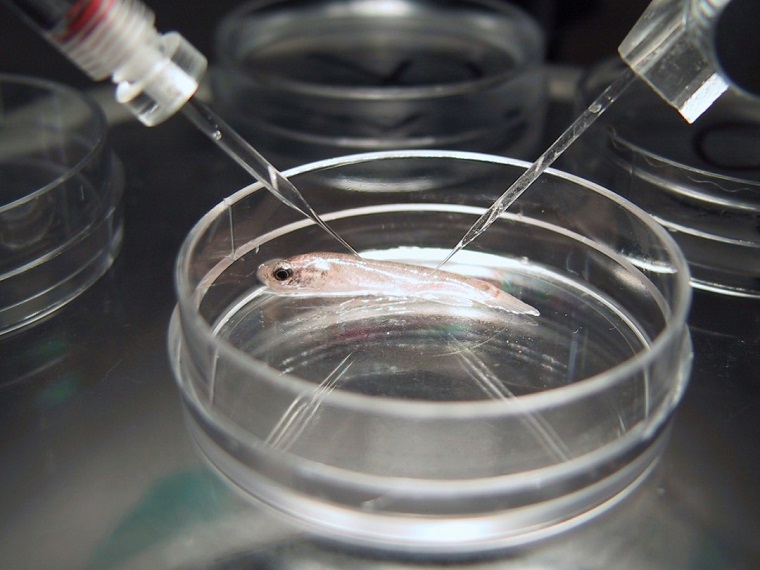Go Ahead and ‘Sweat It’: How to Survive as a Fish Out of Water
By Michael Lim
13 May 2019

It’s an all too common story. Spurred on by the insistence of others, you find yourself thrust into a situation you’re not used to, leaving you uncomfortable and — usually figuratively — floundering about. Amphibious fish put a different spin on the classic idiom, not only voluntarily going from water to land, but often surviving for months without re-entering water. Amphibious animals have long been a curiosity for researchers seeking to understand how life first transcended the barrier between water and land millions of years ago.
The first terrestrial ‘colonizers’ faced many physiological challenges – not the least of which was dealing with nitrogen waste products. When breaking down ingested proteins, all animals produce the nitrogen waste product ammonia, which is lethal at high concentrations. Unlike terrestrial animals which convert ammonia into less toxic urea or uric acid, most aquatic animals require large amounts of water to excrete ammonia through their gills. So how does an amphibious fish avoid ammonia toxicity when switching from an aquatic to terrestrial environment?
For nearly two decades, Prof. Patricia Wright, Department of Integrative Biology, has been investigating nitrogen excretion in amphibious fish. Research by Wright and others has revealed several different strategies used by amphibious animals to cope with ammonia toxicity, including increasing conversion of ammonia into urea, and accumulating ammonia in the body until it can be released when re-entering water. But one method that particularly caught the attention of Wright was the ability of the mangrove rivulus, an amphibious fish native to Central and South America, to excrete ammonia through their skin, where it is then vaporized.
“The skin acts like a substitute gill when fish leave water,” says Wright, who first discovered the phenomenon in 2002. “The ability to continuously excrete ammonia is key for fish to survive and remain active out of water for extended periods of time.”

field (photo by Louise Tunnah)
Now, a new study by Wright and undergraduate researcher Michael Livingston has found that the mangrove rivulus’ remarkable ability to switch ammonia excretion from its gills to skin may be more widespread in the aquatic world than previously realized.
Livingston measured ammonia and urea excretion in six different species of amphibious fish living out water, and quantified the levels of “Rhesus” proteins in their skin. Rhesus proteins serve as channels within skin cells that transport ammonia to the environment. By tagging Rhesus proteins with a specific fluorescent dye, Livingston could quantify the presence and magnitude of Rhesus proteins in skin samples.
Livingston discovered that all six species’ primary method of ammonia excretion was through the skin. The finding suggests that ammonia vaporization may have played a key role in the survival of the prehistoric ancestors of these modern amphibious fish – an exciting insight into an important evolutionary event. However, whether this ability arose in a common ancestor or evolved independently across different lineages remains to be determined.
Recent work in the Wright lab has also revealed that some fully aquatic species also contain Rhesus proteins in their skin, despite never venturing onto land. Larval fish are known to excrete ammonia through their skin while their gills are still developing, but research is currently ongoing to investigate why some aquatic species continue to use their skin to excrete ammonia into adulthood.
Wright also plans to continue studying amphibious species and how they cope with combinations of stressors such as high levels of ammonia or low levels of oxygen. Combined stressors may result in amphibious fish leaving water earlier compared to individual stressors.
“Studying existing amphibious species helps us understand the challenges faced by our early vertebrate ancestors that transitioned to land,” says Wright. “It is fascinating to explore the diversity of strategies that have evolved to cope with the amphibious lifestyle.”
Other contributors to this project include Vikram Bhargav and Andy Turko (University of Guelph), and Jonathan Wilson (Wilfrid Laurier University) who provided his expertise in immunohistochemistry. Funding was provided by the Natural Sciences and Engineering Research Council.
Read the full study in the journal Proceedings of the Royal Society B: Biological Science.
Read about other CBS Research Highlights.